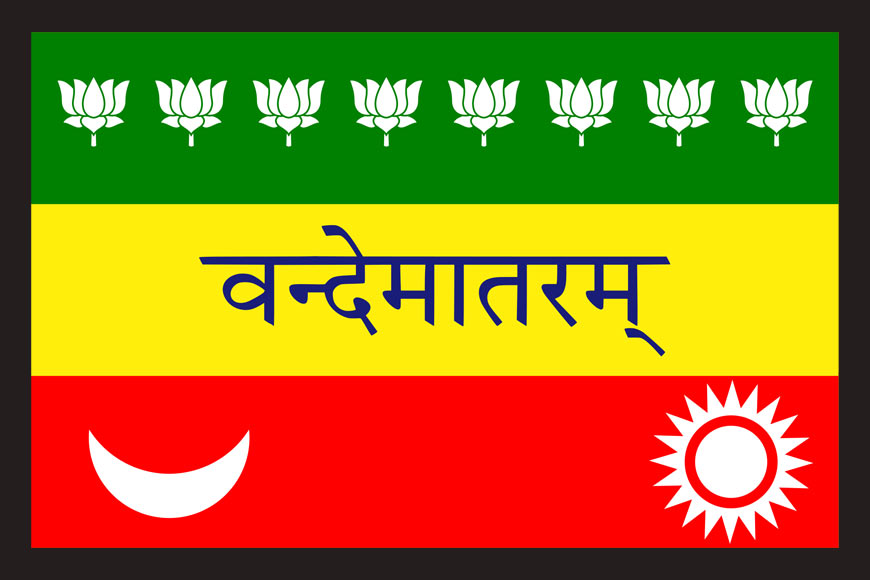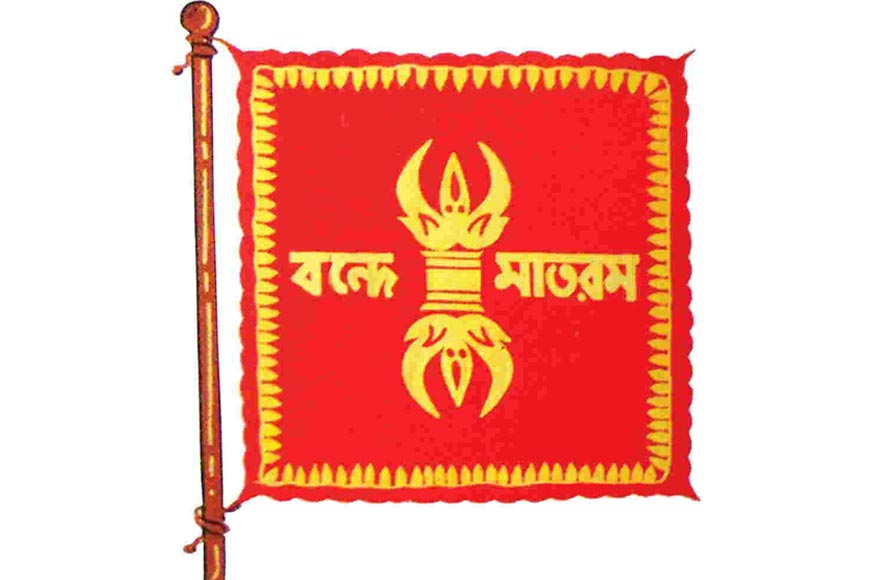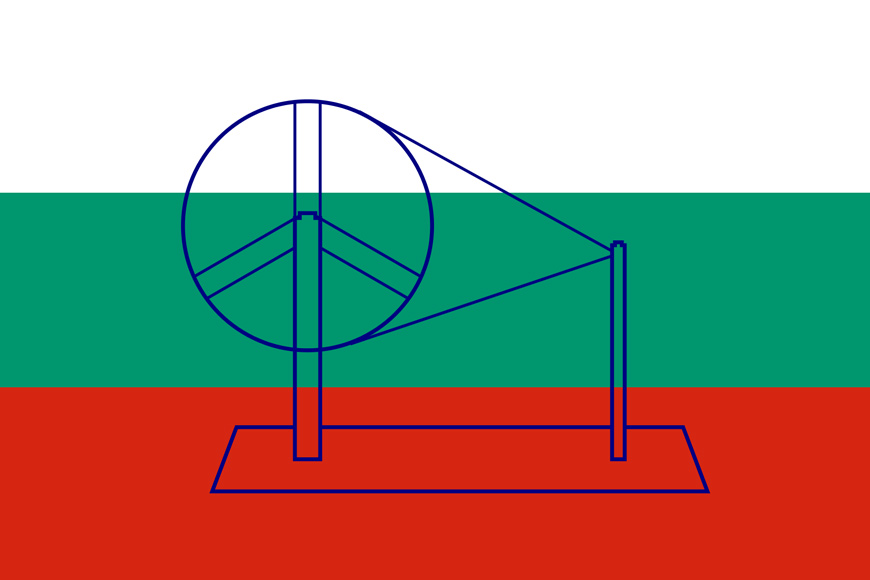On India’s Flag Adoption Day, acknowledging the tricolour’s debt to Bengal

Flag of India 1907 (Nationalists Flag)
Today is what we have come to know as Flag Adoption Day, the day the tricolour was officially adopted as the flag of independent India. What’s more, we are now in the 75th year of said adoption. And still, very few of us know the story behind the story, or the role that Bengal played in our national flag’s eventual design, beginning with the first ever version of the tricolour.
For instance, Srish Chandra Basu (1861-1918) and Lahore are two names inextricably linked to the origins of our flag. Basu was a Bengali Sanskrit scholar, judge, writer and translator, owner of a prestigious publishing house in Allahabad which he called the Panini Office, and founder of the Indian National Society (INS) in Lahore. He devised a ‘national standard’ or flag for INS members and for a while, the INS organised patriotic rallies on the streets of Lahore, where members would carry the flag - two triangles fused together - and sing songs from Basu’s book, ‘Indian National Songs and Lyrics’ (1883).
Five years later in 1888, in a book titled ‘Old Hindu’s Hope or a Proposal of a Hindu National Congress’, Rajnarayan Basu proposed that the lotus be adopted as the national symbol of India, from which we can travel in a straight line to 1904-05, when Sister Nivedita made the first big push for a national flag, with the ‘vajra’ or thunderbolt as its mainstay.
The idea of the vajra first came to her during a trip to Bodhgaya in 1904, accompanied by Rabindranath Tagore, Acharya Jagadish Chandra Bose, Sir Jadunath Sarkar, Swami Shankaranand, and Mathuranath Sinha. In Buddhist philosophy, the vajra stands for selfless humanity, while Hindus know it as the weapon fashioned out of the ascetic Dadhichi’s bones for Lord Indra, king of the gods. It is also among the weapons used by the goddess Durga, slayer of demon king Mahishasura.
In 1909, using the pseudonym RS, Nivedita wrote an illustrated essay titled ‘The Vajra as a National Flag’ for the November edition of Modern Review, which is quite possibly the first published work on India’s national flag. The essay began, “The question of the invention of a flag for India is beginning to be discussed in the press. Those who contemplate the desirability of such a symbol, seem to be unaware that already a great many people have taken up, and are using, the ancient Indian Vajra or Thunderbolt...”

The vajra flag captured the imagination of quite a few people, and was eminently visible during the 1905 ‘Bangabhanga Andolan’, or the movement against the first partition of Bengal. It was also publicly displayed at the 1906 session of the Congress, supported by the likes of AJC Bose and many other prominent citizens. However, the flag never really caught on with the masses, and was quietly relegated to obscurity, though it continued to be discussed in writing for several decades.
On August 7, 1906, in commemoration of the first anniversary of the Bangabhanga Andolan, the first Indian tricolour in green, yellow, and red was raised at Parsi Bagan (Sadhana Sarkar Udyan in Garpar today), as Bhupendranath Basu handed the flag to Surendranath Banerjee, who hoisted it to the accompaniment of 101 explosives going off, the equivalent of a gun salute.
Also read : The Indian tricolour, and the myths behind it
Designed by freedom fighter Sukumar Mitra, the flag was stitched by his sister Kumudini Basu, and adopted following the addition of eight white lotuses, the sun and moon, and ‘Vande Mataram’ written across the centre in Devnagri script. This flag was even hoisted at the 1906 Calcutta session of the Congress by Dadabhai Naoroji, but was given a quiet burial once the partition of Bengal was reversed in 1911.
Funnily enough, however, the first tricolour flag was seen exactly a year after it was first raised. On August 22, 1907, at the International Socialist Congress in Stuttgart, Germany, Madame Bhikaji Cama displayed the flag and declared, “This flag is of Indian independence. Behold, it is born”. No mention was made of the flag’s origin or its designers, and writing about this incident in 1922, Dr Bhupendranath Datta, freedom fighter and brother to Swami Vivekananda, claimed that the Stuttgart flag had been designed by Hemchandra Kanungo, who was in Paris at the time, as a copy of Sukumar Mitra’s design, stating that the two designs could not be a coincidence.
Datta also lamented the fact that Bengal was systematically being robbed of its credit in national politics, and all its contributions to Indian history being erased. Indeed, Cama’s biographer Khorshed Ali Sethna even stated in the book ‘Madame Bhikaji Rustom Cama’ (1987) that “The flag was carefully planned and was most probably designed by her (Cama) jointly with Savarkar,” even though Cama herself had ascribed the design to Kanungo.

The journey of the national flag from this point onwards has been documented in another of our articles, but it is important to end with another almost forgotten historian, Dr Radha Kumud Mukherjee, without whose intervention the Ashoka Chakra may not have found a place on the tricolour. Mahatma Gandhi wanted the symbol on the flag to be the ‘charkha’ (spinning wheel), since the Ashoka Chakra, in his opinion, was associated with the Ashokan lion capital and hence, with violence.
Taking it upon himself to convince Gandhiji otherwise, Dr Mukherjee went to see him at Beleghata’s Hydari Manzil. The summary of his argument was that the chakra represents the holy wheel in Buddhism, which in turn originates in the Sudarshan Chakra of Lord Vishnu. Dispelling Gandhiji’s notion that the chakra was a weapon of destruction, Dr Mukherjee said it was rather a symbol of universal creation, quoting Sanskrit texts to prove his point. So satisfied was Gandhiji with the explanation that he actually published an essay supporting the Ashoka Chakra, citing Dr Mukherjee as his source.
From 1883 to 1947, every step of the way in the evolution of the tricolour, Bengal has played a critical role. On Flag Adoption Day, perhaps we should remind ourselves as much.
Information inputs: Shri Sekhar Chakrabarti, vexillologist, writer, researcher









